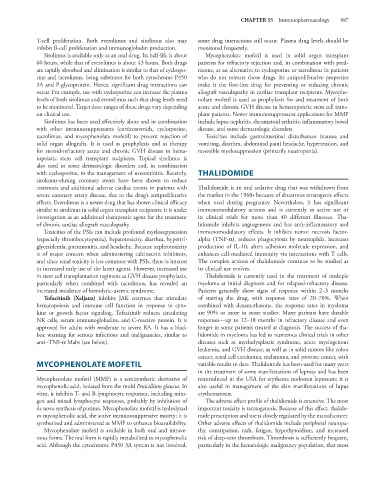Page 1001 - Basic _ Clinical Pharmacology ( PDFDrive )
P. 1001
CHAPTER 55 Immunopharmacology 987
T-cell proliferation. Both everolimus and sirolimus also may some drug interactions still occur. Plasma drug levels should be
inhibit B-cell proliferation and immunoglobulin production. monitored frequently.
Sirolimus is available only as an oral drug. Its half-life is about Mycophenolate mofetil is used in solid organ transplant
60 hours, while that of everolimus is about 43 hours. Both drugs patients for refractory rejection and, in combination with pred-
are rapidly absorbed and elimination is similar to that of cyclospo- nisone, as an alternative to cyclosporine or tacrolimus in patients
rine and tacrolimus, being substrates for both cytochrome P450 who do not tolerate those drugs. Its antiproliferative properties
3A and P-glycoprotein. Hence, significant drug interactions can make it the first-line drug for preventing or reducing chronic
occur. For example, use with cyclosporine can increase the plasma allograft vasculopathy in cardiac transplant recipients. Mycophe-
levels of both sirolimus and everolimus such that drug levels need nolate mofetil is used as prophylaxis for and treatment of both
to be monitored. Target dose-ranges of these drugs vary depending acute and chronic GVH disease in hematopoietic stem cell trans-
on clinical use. plant patients. Newer immunosuppressant applications for MMF
Sirolimus has been used effectively alone and in combination include lupus nephritis, rheumatoid arthritis, inflammatory bowel
with other immunosuppressants (corticosteroids, cyclosporine, disease, and some dermatologic disorders.
tacrolimus, and mycophenolate mofetil) to prevent rejection of Toxicities include gastrointestinal disturbances (nausea and
solid organ allografts. It is used as prophylaxis and as therapy vomiting, diarrhea, abdominal pain) headache, hypertension, and
for steroid-refractory acute and chronic GVH disease in hema- reversible myelosuppression (primarily neutropenia).
topoietic stem cell transplant recipients. Topical sirolimus is
also used in some dermatologic disorders and, in combination
with cyclosporine, in the management of uveoretinitis. Recently, THALIDOMIDE
sirolimus-eluting coronary stents have been shown to reduce
restenosis and additional adverse cardiac events in patients with Thalidomide is an oral sedative drug that was withdrawn from
severe coronary artery disease, due to the drug’s antiproliferative the market in the 1960s because of disastrous teratogenic effects
effects. Everolimus is a newer drug that has shown clinical efficacy when used during pregnancy. Nevertheless, it has significant
similar to sirolimus in solid organ transplant recipients; it is under immunomodulatory actions and is currently in active use or
investigation as an additional therapeutic agent for the treatment in clinical trials for more than 40 different illnesses. Tha-
of chronic cardiac allograft vasculopathy. lidomide inhibits angiogenesis and has anti-inflammatory and
Toxicities of the PSIs can include profound myelosuppression immunomodulatory effects. It inhibits tumor necrosis factor-
(especially thrombocytopenia), hepatotoxicity, diarrhea, hypertri- alpha (TNF-α), reduces phagocytosis by neutrophils, increases
glyceridemia, pneumonitis, and headache. Because nephrotoxicity production of IL-10, alters adhesion molecule expression, and
is of major concern when administering calcineurin inhibitors, enhances cell-mediated immunity via interactions with T cells.
and since renal toxicity is less common with PSIs, there is interest The complex actions of thalidomide continue to be studied as
in increased early use of the latter agents. However, increased use its clinical use evolves.
in stem cell transplantation regimens as GVH disease prophylaxis, Thalidomide is currently used in the treatment of multiple
particularly when combined with tacrolimus, has revealed an myeloma at initial diagnosis and for relapsed-refractory disease.
increased incidence of hemolytic-uremic syndrome. Patients generally show signs of response within 2–3 months
Tofacitinib (Xeljanz) inhibits JAK enzymes that stimulate of starting the drug, with response rates of 20–70%. When
hematopoiesis and immune cell function in response to cyto- combined with dexamethasone, the response rates in myeloma
kine or growth factor signaling. Tofacitinib reduces circulating are 90% or more in some studies. Many patients have durable
NK cells, serum immunoglobulins, and C-reactive protein. It is responses—up to 12–18 months in refractory disease and even
approved for adults with moderate to severe RA. It has a black longer in some patients treated at diagnosis. The success of tha-
box warning for serious infections and malignancies, similar to lidomide in myeloma has led to numerous clinical trials in other
anti–TNF-α Mabs (see below). diseases such as myelodysplastic syndrome, acute myelogenous
leukemia, and GVH disease, as well as in solid tumors like colon
cancer, renal cell carcinoma, melanoma, and prostate cancer, with
MYCOPHENOLATE MOFETIL variable results to date. Thalidomide has been used for many years
in the treatment of some manifestations of leprosy and has been
Mycophenolate mofetil (MMF) is a semisynthetic derivative of reintroduced in the USA for erythema nodosum leprosum; it is
mycophenolic acid, isolated from the mold Penicillium glaucus. In also useful in management of the skin manifestations of lupus
vitro, it inhibits T- and B-lymphocyte responses, including mito- erythematosus.
gen and mixed lymphocyte responses, probably by inhibition of The adverse effect profile of thalidomide is extensive. The most
de novo synthesis of purines. Mycophenolate mofetil is hydrolyzed important toxicity is teratogenesis. Because of this effect, thalido-
to mycophenolic acid, the active immunosuppressive moiety; it is mide prescription and use is closely regulated by the manufacturer.
synthesized and administered as MMF to enhance bioavailability. Other adverse effects of thalidomide include peripheral neuropa-
Mycophenolate mofetil is available in both oral and intrave- thy, constipation, rash, fatigue, hypothyroidism, and increased
nous forms. The oral form is rapidly metabolized to mycophenolic risk of deep-vein thrombosis. Thrombosis is sufficiently frequent,
acid. Although the cytochrome P450 3A system is not involved, particularly in the hematologic malignancy population, that most

